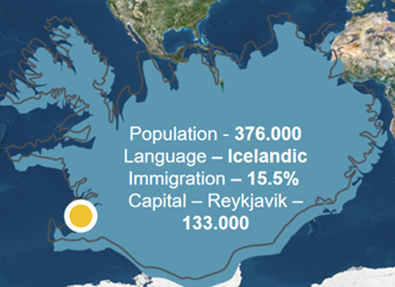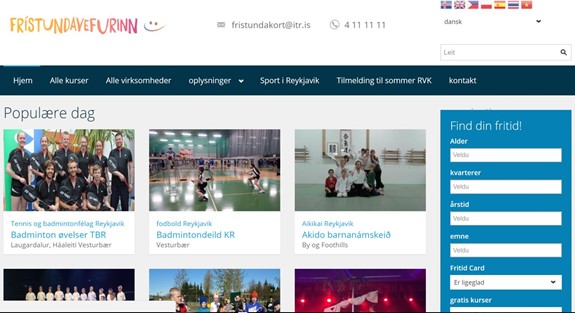In May 2022, we had wonderful opportunity to visit Reykjavik, Iceland. Reykjavik is the capital city of Iceland with a population of 133 000, the same size as my hometown Jyväskylä.
Iceland has developed long and systematically the well-being of children and young people. In the 1990s, there were concerns about young people’s use of drugs and alcohol, as young Icelanders drank the most in Europe. The Icelandic model was built from this, and it’s strongly based on up-to-date knowledge management and co-operation between the state, the municipality, and the commonalty.

Picture 1. The map of Iceland
In Iceland, legislation restricted the purchase of tobacco and alcohol for those under 20 years of age. Advertising on tobacco and alcohol was also banned altogether. In addition, entry times were set, allowing children under the age of 12 to be outside for 8:00 pm and those under the age of 16 to 10:00 pm. During the holidays, arrival times are a few hours later. Volunteer-based parent groups patrol the streets, sending children and young people moving outside too late to their homes. The law registered a parent association to be established in each school, which was used to strengthen the links between parents and schools. Parents’ associations agreed on common rules on which all parents could rely in their educational work. Positive information encouraged parents to spend time with their children and talk to them, get to know their lives and friends.
The Icelandic model prevents and reinforces protective factors.
Many research show that spending time with parents is a strong protective factor. Other equally important factors are participation in guided activities 3-4 times a week and the caring atmosphere of the school. Strengthening social relationships, co-operation skills and respect for others are important parts of the whole. Children and young people are active participants in democratic decision-making and in the planning of matters concerning them.
The hobbies are organized in co-operation with local sports clubs and other organizations. After the school day, there are various leisure activities for 6–18-year-olds, you can use a Fritid Card. Iceland donates 420 euros for all age groups, which is loaded on the card and can be used for pleasing activities. An afternoon program is like Finnish afternoon activities, and it is available for younger schoolchildren, with a fee (€ 130 /As month).

Picture 2. Fritid Card
As many as 80% of 13–15-year-old participate in leisure activities and 90% of parents have experienced positive development in social skills. At present, Iceland is at the forefront due to the low level of drug use among young people and the good debate with parents.
What new we got involved from our travel?
The Icelandic model has also been behind the Finnish Model for leisure activities, which is a project of the Ministry of Education and Culture. The main aim is to increase the well-being of children and young people. The goal is to enable every child and youth to have a pleasing and free hobby during the school day. The implementation of the government program was prepared by a working group, and the hobby model was started as a project in 2019 and is planned to be binding on municipalities under the Youth Act in the future. In connection with the student survey 2021, we asked about hobby wishes and developing activities. Communication came to the fore, meaning that it was difficult to find information about the hobbies of the schools.
There was an electronic booking system on the website in Iceland, and this will be tested in Jyväskylä next year. In this way, information about the offerings of other schools was also shared more widely. Sports activities were the most popular in Iceland, as well as in Jyväskylä. During the visit to Iceland, we were able to take advantage of how the results of the surveys and research data were reviewed, both with parents and children, and the positive information was used to influence attitudes. For example, the reduction of screen time and the privilege to good sleep were emphasized, as was the importance of good health for overall well-being. Information management is one of the forefronts of the city of Jyväskylä’s new strategy, so children can be involved in the future and children will also be involved in processing the results.
The funding for the Finnish hobby model is small for the Icelandic model. The city of Reykjavik alone is budgeting about 50 million to support the hobbies of children and young people. The realization of the dream is therefore not free, but its consequences will go far into the future of children and young people.
Picture 3. Fritid booking system

Blog writer: Tella Vuolle-Oranen, Welfare and Health Coordinator -student from Savonia UAS
References:
Jyväskylän kaupunki. Harrastamisen Suomen malli (2021-). Verkkojulkaisu. Päivitetty 17.5.2022. https://www.jyvaskyla.fi/talous-ja-strategia/hankkeet/harrastamisen-suomen-malli. Viitattu 20.6.2022.
Young, Emma 2017. How Iceland Got Teens to Say No to Drugs. The Atlantic. Verkkojulkaisu. Päivitetty 19.1.2017. https://www.theatlantic.com/health/archive/2017/01/teens-drugs-iceland/513668/ .Viitattu 20.6.2022.
City of Reykjavik 2022. The Leisure Card. Verkkojulkaisu. https://reykjavik.is/en/fristundakortid. Viitattu 20.6.2022.
City of Reykjavik 2018. Reykjavik City Education Policy 2030. Let our dreams come true. Verkkojulkaisu. https://reykjavik.is/en/administration/governance/policies/education-policy-let. Viitattu 20.6.2022.
